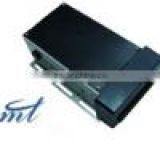433 MHz Wireless transceiver Receiver AVI system for Fueling MT124
USD $1.00 - $1.00 /Piece
Min.Order:1 Piece
Quick Details View All >
SHENZHEN MINGTE TECH CO., LTD.
fuel nozzle with rfid/ rfid for fuel nozzle reader MT123 for Petrol / CNG station
433 MHz vehicle loop detector MT123 for Petrol / Fuel station
433 Wireless communication radio extenders AVI for Fueling station MT12X
RFID Nozzle wireless antennas and vehicle tag uart AVI System for Fuel and CNG company fleet MT12X
RFID automatic refuelling nozzle AVI System for Fuel LNG CNG company fleet MT12X
(AVI) Automatic Vehicle Identification System for Fueling MT12X
Product Details
Overview
The wireless receiver builds wireless network with RFID/contactless technology for AVI systems. It works with MINGTE Wireless Nozzle Reader (MT123) and MINGTE Vehicle Tag (MT125). It is flexible, secure and easy to install & setup & upgrade etc.
MT124 Features
1 :Reliable, flexible and robust
2 :Easy to install, operate & upgrade
3 :Manages up to 16 wireless nozzle readers
4 :Software and functions updated
5 :Supports wireless & RS232 communication
6 :Supports Nozzle Reader address identification
Applications
1 :Automatic Vehicle Identification (AVI) System for fueling
2 :Fuel Dispensers, CNG Dispensers, Fuel Stations, CNG Stations, Fuel Company, CNG Company, Fleets, Service Provider
Specifications
CATEGORY | Wireless Receiver |
COMMUNICATION RANGE WITH MT123 | Approx 80m(Related to working environment) |
COMMUNICATION | Communication with MINGTE wireless nozzle reader (MT123) and transmitting data to controlling system via RS-232 |
WORKING TEMPERATURE | -20℃-+55℃ |
WIRELESS COMMUNICATION FREQUENCY | 433 MHz |
POWER SUPPLY | DC5V ± 5% |
CURRENT | ≤500mA |
DIMENSIONS(MM) | 244.6mm(W)x162.8mm(D)x36mm(H) |
WEIGHT | 400g( packing & accessories not included) |
REMARKS | With nozzle reader address identification function |
How Does It Work?
1: Vehicle Tag
2: Anti-vandal Radio Frequency Nozzle (RFN)
3: Wireless Receiver
4: Fuel Dispensers Controlling Systems
5:Communication Hub
6: Fuel Dispensers
7: Fuel Card
Steps:
1: Insert fuel card.
2: Fuel dispensers transmit information (e.g., fuel card No. or user info) in fuel card to fuel dispensers controlling systems.
3: Insert radio frequency nozzles, the vehicle tag details (e.g., identification No.) are validated.
4: Vehicle tag details are transmitted to petro station controlling systems during authorization process.
5: When wireless communication between the vehicle and nozzle is maintained, fuel will be dispensed.
6: Once refueling is complete, the nozzle is returned to the pump.
Other components:
Contact Supplier

You May Like






New Products
Popular Searches
Recommended Products
Find Similar Products By Category